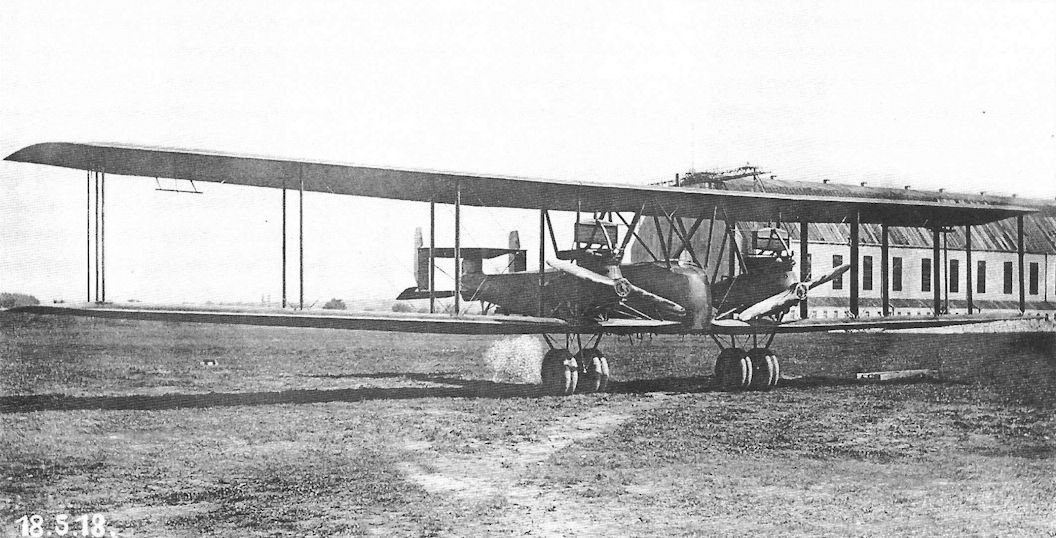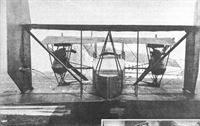
Описание
Страна: Германия
Год: 1918
Варианты
- Friedrichshafen - G.I/G.II/G.III (FF30/FF38/FF45) - 1915 - Германия
- Friedrichshafen - G.IV (FF61) - 1918 - Германия
- Friedrichshafen - G.V (FF62) - 1918 - Германия
- O.Thetford, P.Gray German Aircraft of the First World War (Putnam)
- J.Herris Friedrichshafen Aircraft of WWI (A Centennial Perspective on Great War Airplanes 21)
-
J.Herris - Friedrichshafen Aircraft of WWI /Centennial Perspective/ (21)
Fdh FF62 (G.V) (1918). The FF62 was designed as a bomber with two 260 hp Daimler D.IVa engines. Only one prototype (G.901/17) was built in 1918. Maiden flight: November 20, 1918.
Photographed May 18, 1918, the Friedrichshafen G.V represented a significant modification of the basic Friedrichshafen bomber airframe. The nose turret was removed and the engines were mounted in tractor configuration, enabling them to be moved closer to the aircraft's centerline. This reduced asymmetric thrust after an engine failure, making the aircraft easier to control. Good handling qualities were vital to flight safety, especially during night landings, and the G.V also featured Flettner tabs on the ailerons to reduce the control forces, making flight less tiring for the pilot. The box tail featured a fixed central fin, which was tested but not used on earlier production Friedrichshafen bombers. The Friedrichshafen FF55, given the military designation G.V, was powered by 245 hp Maybach Mb.IVa engines for higher ceiling and speed at altitude with the intention of high-altitude day bombing, although the basic airframe was also tested as the FF62 with the 260 hp Mercedes D.IVa as a night bomber. Only three FF55 aircraft with Maybach engines and one FF62 with Mercedes engines were completed before the Armistice, so the G.V did not see operational service. Photographs showing G.V 900 and G.V 901 are probably G.900/17 and G.901/17.The prominent drag-producing radiators must have adversely affected maximum speed, likely one reason the Gotha GL.VII series was favored for day bombing. The brace supporting the tail has been retouched out of the photo. (Peter M. Bowers Collection, Museum of Flight) -
J.Herris - Friedrichshafen Aircraft of WWI /Centennial Perspective/ (21)
FF62, the prototype G.V with Mercedes engines.
-
J.Herris - Friedrichshafen Aircraft of WWI /Centennial Perspective/ (21)
Fdh FF55 (1918). The FF55 was a design for a twin-engine fast bomber with the oversized 260 hp Maybach Mb.IVa high-altitude engine, based on the tenders of spring 1918. The tip of the fuselage only begins behind the propeller plane, which made it possible to move the engines closer together. The FF55 did not go into series production as the Gotha G.VII was preferred. Maiden flight: May 19, 1918.
The Friedrichshafen G IV was a four-bay version of the G IIIa. The increased wing area allowed it to fly on one engine for 70-90 minutes from a height of 3,000m until it reached the ground, which was a great improvement on other types in use. Further attempts to improve single-engine performance produced the Friedrichshafen G V; by shortening the fuselage nose, the engines could be placed closer together, thus reducing their asymmetric moment. This is the G V prototype with a centre fin added to its biplane tail unit during a modification programme. The aircraft had a payload of 2,100kg but had not been placed into production before the Armistice. -
O.Thetford, P.Gray - German Aircraft of the First World War /Putnam/
Friedrichshafen FF 62
-
J.Herris - Friedrichshafen Aircraft of WWI /Centennial Perspective/ (21)
A Friedrichshafen G.V prototype carrying a 1,000 kg P.u.W. bomb photographed on May 9, 1918, the day of its first flight. Doubled wheels are fitted to support the additional weight. Unlike the Friedrichshafen G.IIIa and G.IV, the box tail now has a fixed fin. Like AEG and Gotha, Friedrichshafen continuously experimented the tail configuration of its bombers in a search for improved handling qualities, especially after an engine failure. Provision was apparently made for a fixed gun for the pilot, which makes sense for an aircraft originally intended for high-altitude daylight bombing. The brace supporting the tail has been retouched out of the photos. (Peter M. Bowers Collection, Museum of Flight)
-
J.Herris - Friedrichshafen Aircraft of WWI /Centennial Perspective/ (21)
This rear view shows the tail details of the Friedrichshafen FF62, the version of the Friedrichshafen G.V airframe that used Mercedes D.IVa engines. The tractor engine configuration was not used in earlier Friedrichshafen bombers, but elimination of the forward gun turret enabled the engines to be mounted closer to the fuselage centerline if they were mounted as tractors.
O.Thetford, P.Gray German Aircraft of the First World War (Putnam)
Friedrichshafen FF 62
No details available of this twin-engined bomber, but probably similar to the G IV, and may possibly have been designated G V
Описание:






